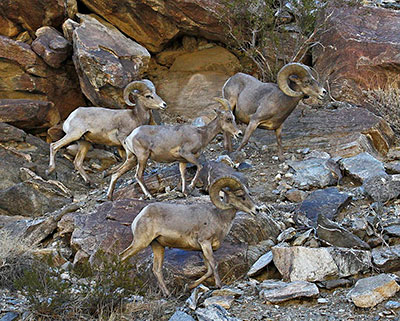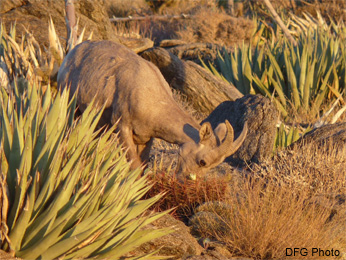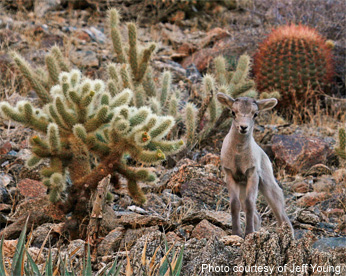 Three rams and a ewe in the peninsular ranges. Photo © Jeff Young, all rights reserved.
Three rams and a ewe in the peninsular ranges. Photo © Jeff Young, all rights reserved.


Bighorn sheep (Ovis canadensis) are divided into three distinct subspecies based on recent morphometric and genetic evidence. Two of these subspecies are found in California, Sierra Nevada bighorn ( O. c. sierrae) and desert bighorn ( O. c. nelsoni) – Range Map (PDF).
The peninsular population of desert bighorn sheep are native ungulates that live on the desert slopes of the Peninsular Ranges in San Diego, Riverside, and Imperial Counties. This population, which ranges from the San Jacinto Mountains south to the U.S.-Mexico border, is federally listed as endangered. Although once considered a separate subspecies ( O. c. cremnobates ), bighorn sheep of the Peninsular Ranges have recently been combined with desert bighorn sheep in the subspecies O. c. nelsoni.
Desert bighorn sheep inhabit rocky slopes and cliffs, canyons, washes and alluvial fans. Like other bighorn sheep, they prefer rugged and open habitat, and use their climbing abilities, vigilance, and excellent vision to detect and escape from predators. They are generalist herbivores and eat a wide variety of desert plants, including cacti. In summer, the distribution of desert bighorn sheep is often associated with scarce water sources. Female bighorn sheep (ewes) live in groups with their offspring, and have smaller home ranges than males (rams). Males move between female groups, joining them during the fall breeding season. Most lambs are born in spring when desert plant productivity is highest.
Learn more: